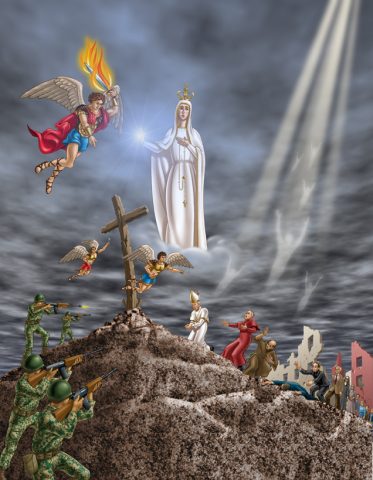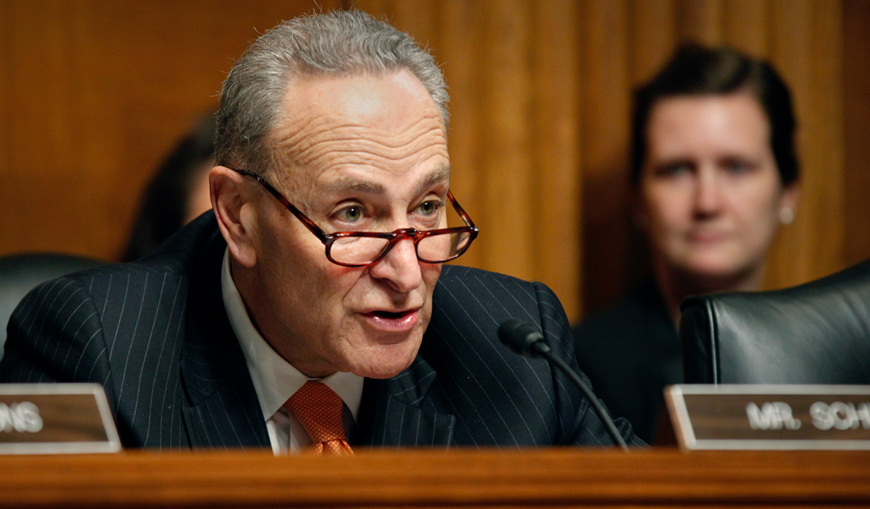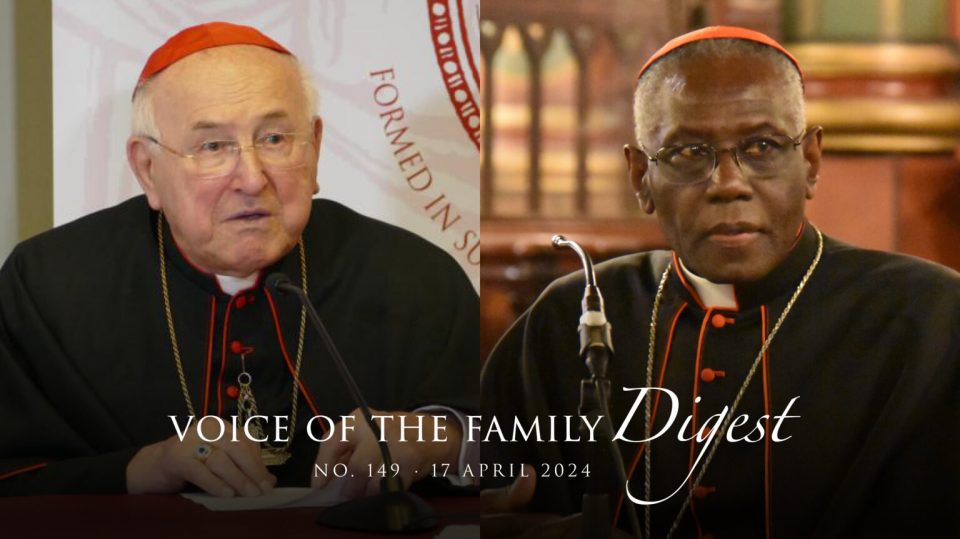Getting Fatima Right by Jimmy Akin

Msgr. Charles Pope: The Cross Is a Fruit-Bearing Tree – A Homily for the Second Sunday of Lent
March 18, 2019
Ben Shapiro: ‘Hilarious’ That The New York Times Is Complaining ‘About China’s Declining Birthrate’
March 18, 2019
Author Jimmy Akin, March 16, 2019
In 1915, as World War I raged in Europe, a Portuguese girl saw something strange in the sky.
The girl—Lucia dos Santos—was seven years old and lived near the town of Fatima. One day, as she was tending her family’s sheep along with three other girls, they began to say the rosary and saw a strange sight.
In the second of four memoirs she would write, Lucia recalled: “We saw a figure poised in the air above the trees; it looked like a statue made of snow, rendered almost transparent by the rays of the sun.” She also wrote, “It looked like a person wrapped up in a sheet.”
They did not know what to make of the sight, and it vanished when they finished praying. The same thing happened on two more occasions.
The angel of peace
In the spring of 1916, Lucia and her cousins Francisco and Jacinta Martos (then 7 and 6) began seeing an angel.
It appeared as “a young man, about fourteen or fifteen years old, whiter than snow, transparent as crystal when the sun shines through it, and of great beauty.”
The angel identified itself as “the angel of peace” and as the guardian angel of Portugal. Lucia understood it to be the same figure she had seen in the sky.
The angel appeared to the children on three occasions, taught them prayers, and during the last appearance showed them a host and chalice that hung miraculously in the air. It then gave them Holy Communion.
‘I am from heaven’
On May 13, 1917, the three were again tending their sheep when they perceived what they thought was a flash of lightning. As they hurried home, there was another flash, and they beheld a beautiful woman in a hemlock tree that grew in a field known as the Cova da Iria.
“We beheld a Lady all dressed in white. She was more brilliant than the sun and radiated a light more clear and intense than a crystal glass filled with sparkling water, when the rays of the burning sun shine through it” (Fourth Memoir).
When asked where she was from, the Lady replied, “I am from heaven.” She requested that the children return to the spot once a month for six months.
She also informed the children that they would go to heaven, and she asked if they were wiling to offer themselves to God and bear the sufferings he would send them, in reparation for sin and the conversion of sinners. They replied they would.
She also told them: “Pray the rosary every day, in order to obtain peace for the world and the end of the war.”
“Jesus wishes to make use of you”
When the Lady reappeared the next month, Lucia asked her to take the three children to heaven, and she replied, “I will take Jacinta and Francisco soon. But you are to stay here some time longer. Jesus wishes to make use of you to make me known and loved. He wants to establish in the world devotion to my Immaculate Heart.”
This prediction was fulfilled. In 1918, toward the end of the war, a global flu pandemic took the lives of millions. Among them were Francisco, who died in 1919, and Jacinta, who died in 1920. Lucia would not die until 2005 at the age of 97.
A secret revealed
At the July apparition, the Lady promised that, in October, she would identify herself and perform a miracle so that all might see and believe.
She also gave the children a secret, which included a vision of hell that caused Lucia to cry out. Afterward, the Lady said:
“You have seen hell where the souls of poor sinners go. To save them, God wishes to establish in the world devotion to my Immaculate Heart. If what I say to you is done, many souls will be saved and there will be peace. The war is going to end; but if people do not cease offending God, a worse one will break out during the pontificate of Pius XI. When you see a night illumined by an unknown light, know that this is the great sign given you by God that he is about to punish the world for its crimes, by means of war, famine, and persecutions of the Church and of the Holy Father.
“To prevent this, I shall come to ask for the consecration of Russia to my Immaculate Heart, and the Communion of Reparation on the First Saturdays. If my requests are heeded, Russia will be converted, and there will be peace; if not, she will spread her errors throughout the world, causing wars and persecutions of the Church. The good will be martyred, the Holy Father will have much to suffer, various nations will be annihilated. In the end, my Immaculate Heart will triumph. The Holy Father will consecrate Russia to me, and she will be converted, and a period of peace will be granted to the world. In Portugal, the dogma of the Faith will always be preserved; etc. . . . Do not tell this to anybody.”
Arrested
The children were prevented from returning to the site on August 13 because the local mayor—an opponent of the apparitions—had the young visionaries arrested. Despite threatening them, he was unable to get them either to admit that they were lying or to reveal the secret.
Pilgrims who had gathered at the site of the apparitions reported strange phenomena. Some said they saw a blue and white cloud descend and then ascend again, some reported lightning, and some reported seeing our Lady.
‘A chapel that is to be built’
Since the children had not been able to come to the site of the apparitions on August 13, the Lady appeared to them a few days later.
When asked what should be done with money that pilgrims were leaving at the apparition site, she indicated that two processional litters should be made for the feast of Our Lady of the Rosary, adding, “What is left over will help toward the construction of a chapel that is to be built here.”
On September 13, large crowds of pilgrims greeted the children and urged them to present their petitions to the Lady.
As the children and the crowd prayed the rosary, she appeared, this time promising, “In October our Lord will come, as well as Our Lady of Dolors and Our Lady of Carmel. Saint Joseph will appear with the Child Jesus to bless the world.”
The miracle of the sun
On October 13, the Lady said, “I am the Lady of the Rosary. Continue always to pray the rosary every day. The war is going to end, and the soldiers will soon return to their homes.”
According to Lucia, the Lady opened her hands, “made them reflect on the sun, and as she ascended, the reflection of her own light continued to be projected on the sun itself.”
Lucia then called for people to look at the sun, and an event called “the miracle of the sun” occurred. Although not everyone claimed to see the phenomenon, numerous individuals reported that the sun appeared to change colors, spin, and “dance” in the sky.
In the wake of this event, the children reported visions of St. Joseph, the Child Jesus, and our Lady in various guises, including Our Lady of Dolors and Our Lady of Carmel, as had been promised.
First Saturdays devotion
In the July 1917 apparition, the Lady had indicated that she would request a devotion involving the First Saturdays of the months.
This request was made on December 10, 1925, when Lucia was a novice among the Dorothean Sisters. On that day, Sr. Lucia experienced an apparition of the Virgin Mary and the Child Jesus, in which Mary said:
“All those who during five months, on the first Saturday, go to confession, receive Holy Communion, say a rosary, and keep me company for fifteen minutes, meditating on the fifteen mysteries of the rosary for the intention of making reparation to me, I promise to assist them at the hour of death, with all the graces necessary for the salvation of their souls” (Documents on Fatima & the Memoirs of Sister Lucia, 279-280).
On January 15, 1926, she experienced an apparition of the Child Jesus, asking if she had spread this devotion, which has come to be known as the First Saturdays devotion.
Consecration requested, apparitions approved
The July 1917 apparition also indicated a request would be made for the consecration of Russia, and this was done on June 13, 1929. On that night, Sr. Lucia experience a vision of the Holy Trinity and the Virgin Mary, in which Mary said:
“The moment has come in which God asks the Holy Father, in union with all the bishops of the world, to make the consecration of Russia to my Immaculate Heart, promising to save it by this means” (Documents on Fatima & the Memoirs of Sister Lucia, 393-394).
On October 13, 1930, the bishop of Leiria, Portugal—in whose territory Fatima lies—granted formal approval for the 1917 apparitions, declaring “as worthy of credence the visions of the children in the Cova da Iria, parish of Fatima, of this diocese, on the thirteenth day of each month from May to October 1917” (Documents on Fatima & the Memoirs of Sister Lucia, 290).
“An unknown light”
In the July 1917 apparition, the Lady stated that the war (World War I) would end but that a worse one could break out in the reign of Pius XI, who would not be elected until 1922. The sign presaging this event was to be “a night illumined by an unknown light.”
On the night of January 25-26, 1938, an extraordinary display of the aurora borealis was widely visible in Europe. In her Third Memoir, Sr. Lucia interpreted this as the sign indicating the new war was close.
World War II broke out the following year.
The third part of the secret
Between 1935 and 1941, Sr. Lucia wrote a series of four memoirs concerning the 1917 apparitions and her cousins.
In the Third Memoir, she revealed the first two parts of the secret they had been given on July 13, 1917: the vision of hell and the material concerning Russia and the pope, along with the forthcoming requests for the First Saturdays devotion and the consecration of Russia.
However, she did not reveal the third part at that time. On January 3, 1944, at the request of her bishop, Sr. Lucia did record it, placing the text in a sealed envelope, which in 1957 was transferred to the Holy See.
Before giving the sealed envelope containing the third part of the “secret” to the then bishop of Leiria-Fatima, Sr. Lucia wrote on the outside envelope that it could be opened only after 1960, either by the patriarch of Lisbon or the bishop of Leiria. Archbishop Bertone therefore asked: “Why only after 1960? Was it our Lady who fixed that date?” Sr. Lucia replied: “It was not our Lady. I fixed the date because I had the intuition that before 1960 it would not be understood, but that only later would it be understood” (The Message of Fatima; all subsequent quotations are taken from this document).
When 1960 came, the Holy See chose not to reveal the third part of the secret.
Assassination attempt
On May 13, 1981—the anniversary of the first Fatima apparition—a Turkish man named Mehmet Ali Agca shot John Paul II in St. Peter’s Square. The pope almost died from the wound, but surgeons were able to save his life.
Though Agca has repeatedly changed his story, it is widely thought he was acting on behalf of Communist forces wishing to neutralize the Polish pope, who went on to play a key role in the downfall of Soviet Communism.
On July 18, 1981, John Paul II read the third part of the secret for the first time and learned what it contained.
The consecration performed
As early as 1942, Pius XII consecrated the entire world to the Immaculate Heart of Mary, and in 1952 he specifically consecrated Russia.
Following the assassination, while he was still recuperating, John Paul II had a special act of entrustment performed on June 7, 1981, and it was repeated in Fatima on May 13, 1982.
However, there was a question of whether these fulfilled the request made by the Virgin Mary, as she had asked that the pope perform the consecration “in union with all the bishops of the world.”
Consequently, “in order to respond more fully to the requests of ‘our Lady’ . . . on 25 March 1984 in St. Peter’s Square, while recalling the fiat uttered by Mary at the Annunciation, the Holy Father, in spiritual union with the bishops of the world, who had been ‘convoked’ beforehand, entrusted all men and women and all peoples to the Immaculate Heart of Mary.”
Subsequently, in a letter dated November 8, 1989, Sr. Lucia confirmed that the consecration had been done, writing, “Yes, it has been done just as our Lady asked, on 25 March 1984.”
The fall of communism
The Cold War, which began in the wake of World War II, was a tense period. It saw various conflicts; national borders were redrawn (“various nations will be annihilated”), and the world itself was threatened by the prospect of nuclear war.
In 1989, the Soviet bloc collapsed, and in 1991 the Soviet Union itself dissolved, with the Communist Party losing power in Russia.
Beatification and disclosure
In 2000, John Paul II beatified Francisco and Jacinta. He also decided that the time had come to release the third part of the secret, and the Holy See issued The Message of Fatima, which contained it along with supporting documents.
The third part of the secret turned out to be a vision of destruction in which an assassination attempt was made on the pope. Others also were martyred.
Interpreting the secret
The first part of the secret was a vision of hell, the ultimate consequence of human sin, and the second and third parts contained references to how human sin would play out in the course of the twentieth century.
The Lady referred to the end of World War I and the outbreak of World War II.
According to Sr. Lucia, “The third part of the secret refers to our Lady’s words: ‘If not, [Russia] will spread her errors throughout the world, causing wars and persecutions of the Church. The good will be martyred; the Holy Father will have much to suffer; various nations will be annihilated.’”
The third part of the secret therefore seems to refer in a special way to the Cold War and the persecution of the Church by atheistic Communism.
“The vision of Fatima concerns above all the war waged by atheistic systems against the Church and Christians, and it describes the immense suffering endured by the witnesses of the faith in the last century of the second millennium. It is an interminable Way of the Cross led by the popes of the twentieth century.”
The assassination attempt on John Paul II on the anniversary of the first Fatima apparition, along with his act of consecration and his role in the fall of Soviet Communism, seems to indicate that he, in a special way, was tied to the fulfillment of the prophecy.
John Paul II regarded the fact he survived the assassination attempt as a special grace. “Sr. Lucia was in full agreement with the pope’s claim that ‘it was a mother’s hand that guided the bullet’s path and in his throes the pope halted at the threshold of death.’”
The significance of Fatima
The Church teaches that private revelations like Fatima do not have the same status as the public revelation God has given us in Scripture and Tradition.
The latter requires the assent of faith, but private revelations—even when approved—do not. The “ecclesiastical approval of a private revelation has three elements: the message contains nothing contrary to faith or morals; it is lawful to make it public; and the faithful are authorized to accept it with prudence.”
The purpose of private revelation is to help people live the Faith in particular circumstances, such as the conflicts that affected the Church in the twentieth century. However, even when these circumstances are past, apparitions can have an enduring value going forward.
In The Message of Fatima, Cardinal Joseph Ratzinger (later Pope Benedict XVI) wrote:
Insofar as individual events are described, they belong to the past. Those who expected exciting apocalyptic revelations about the end of the world or the future course of history are bound to be disappointed. Fatima does not satisfy our curiosity in this way, just as Christian faith in general cannot be reduced to an object of mere curiosity. What remains was already evident when we began our reflections on the text of the “secret”: the exhortation to prayer as the path of “salvation for souls” and, likewise, the summons to penance and conversion (ibid.).




